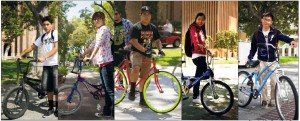Pedal power: a look at bicycle options for students on the move
As anyone who lives on or near campus knows, owning a bicycle puts you at a crucial advantage. Cars are impractical in such cramped quarters and walking is too time-consuming, leaving the simple, man-powered machine as the best option for those craving a stress-free commute to class.
But bikes are more than just two wheels and handlebars. While they all serve the same basic point-A-to-point-B function, bikes come in a variety of forms, each possessing its own set of benefits and pitfalls.
Unfortunately, there is no “best” type of bicycle to get you through college, but there is definitely something for everyone, and because of that, USC’s bicycle population is as diverse as its students.
Below is a sample of some common campus bikes and what each can do for you.
Cruisers
If you haven’t noticed by now, cruisers are the most populous bike type at USC and it’s not hard to see why. In addition to affordability — basic models start at $75, new — cruisers have a comfortable ride that easily complements the constantly sunny Southern California weather. Their unique freewheel-style hub allows coasting, a padded seat gives sofa-style relief and cushy balloon tires make a ride down Trousdale Parkway feel effortless — especially if your textbooks are in your optional front basket.
But for all their easy riding on campus walkways, however, cruisers are also victims of their heavy and cumbersome frame. Though great for slow-speed gliding through brief bursts of flatland, cruisers lack everything else necessary to ride long distance on streets, and owners are left stranded in the USC area.
Fixed gears
Though in the minority of bikes on campus, so-called “fixies” have a long history of helping people get around with their single fixed gear — when the pedals are moving the wheel is moving and vice versa — dating back to the first modern bicycle. Relegated to the velodrome track after the invention of the coastable freewheel, fixed gears have enjoyed a modern renaissance thanks to urban cyclists seeking simple as well as low-maintenance transportation.
In areas with no elevation change — such as those around USC — fixed gears are efficient transportation; however, those that choose to ride fixed on campus do so against practicality. They are hard to fit into the on-campus bike racks, their speed is unusable on pedestrian paths and their new-found popularity makes them targets for theft.
Road bikes
When the Tour de France started in 1903, riders switched gears by dismounting their bike and replacing their back wheel with one of a different-sized cog. But as bike technology finally evolved with the grueling sport of cycling, fixed gears gave way to cable-shifting gears and road bikes were born. Built more for speed and handling than comfort, road bikes have gone through several designs over the years, but all still bear the same identifying characteristics: skinny tires, track-bike geometry and curved-down handlebars for a variety of grip positions.
Today, USC is teeming with retired steel racers that are both cheaper and more durable than their modern carbon-fiber counterparts. But although they are ideal for students because of their ability to ride both cross-campus and cross-town quickly, road bikes unfortunately lack the shock absorption necessary to handle Los Angeles’ often-questionable urban terrain.
Hybrid bike
The word “hybrid” may most commonly be associated with Prius-like cars, but hybrid bicycles have nothing to do with electricity-assisted rides. Instead, they stand in the middle ground between road and mountain bikes, with enough features drawn from each to make it the most versatile type on the market. Available in many varieties — including the city bike and commuter bike — hybrids combine mountain bike durability with road bike efficiency to give riders a multipurpose machine that is ready for anything.
As the ultimate around-town bike, it traditionally pairs an over-sized mountain-bike frame with road bike wheels and always includes attachments for accessories like racks, fenders and panniers. By incorporating elements from across the bike spectrum, hybrids are a safe first purchase for students who are indecisive about their cycling future.
Folding bikes
Created shortly after the fixed-gear original and quickly appropriated by European militaries, folding bikes are enjoying a comeback as utilitarian commuter transport. Nowhere is this bike type more helpful, however, than on college campuses where bike racks are becoming increasingly more impacted and in-dorm storage space a luxury.
Small wheels and a low-to-the-ground frame might make most folding bikes look like a circus prop, but adjustable seat posts and extended handlebars actually give users the same general riding position as conventional bikes. Most collapse in seconds via hinge points along the frame, but this convenience comes at a structural price. Multiple stress points require thicker tubes, so even though they may be easier to transport and store, foldable bikes can weigh just as much as their full-size counterparts.


Good info. If you or someone on the DT staff could do a follow up/expose story on the Trojan revenue source for the city of LA – student bikers! Please list the typical citations given: riding on sidewalks, riding through crosswalks, wearing earphones, all at a cost now of OVER $200 per ticket. and – they typically do not mail you the ticket payment info. If they do – it is after you have moved out. But you are still responsible and then the ticket cost quadruples. They have a racket going on with the students of SC. Please warn students.
not the city’s fault if you’re too dumb to get your mail forwarded when you move…